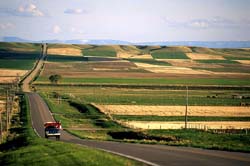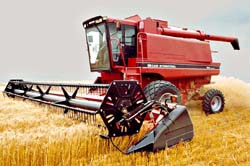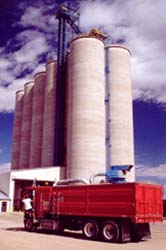Farm Land
Updated: August 18, 2020

Can you guess what the number one industry in Montana is? Let me give you a hint: Montana ranks second in the nation in land use of farms and ranches, with approximately 57 million acres, totaling about 21,064 thousand farms and ranches in 2015. Still don't know? Montana's number one industry is agriculture.
Farmers produce the food that we eat. Whether, it is our cereal for breakfast, our sandwich at lunch, or our steak and potato at dinner, it all begins with the farmer. No wonder farming is a full-time job!

The average size of a farm in Montana is 2,164 acres. The land used to grow crops, or food, is called "cropland." A wide variety of crops are grown throughout the state. Some of these are corn, wheat, potatoes, sugar beets, dry beans, peas, mint, cherries, sunflowers, hay, and safflower. Can you think of some of the other crops that are grown here in Montana?
There are two main styles of farming, dry-land farming and irrigated farming. Dry-land farming is the process of having a loose top soil covered with mulch to protect the moisture, and a firm thick base of dirt. Dryland farmers do not develop any mechanized way to add water to the soil, and most farmers will only plant a dry-land field every other year in order to build up the moisture and minerals.

Irrigated farming is the process of "watering" the crops. This can be done by digging ditches for water to flow into the field, flooding the field, or using sprinklers. Certain crops grow better in irrigated land whereas other crops grow better in dry-land. A farmer has to know what crops will grow best and produce a better yield.

The farmer has a very busy schedule. He or she has to plan far into the year to prevent mistakes from happening and to protect against damaging weather. Let's take a look at a farmer's cropland schedule:
- Select crop variety suitable to the climate and soil.
- Plow soil to bury leftover crops, aerate (provide air to the soil), and control the weeds.
- Disc soil to break up dirt clods and prepare it for planting.
- Harrow soil, or continue to break up clods of dirt into fine grains.
- Fertilize soil by spraying chemicals.
- Plant seeds.
- Cultivate, or dig up soil, to control weeds.
- Spray to control pests (weeds, insects, rodents).
- Irrigate
- Harvest, or pick the crops from the field.
Once the crops are harvested they are processed and delivered to grocery stores, factories, and restaurants. So the next time that you bite into a fresh piece of corn or pour a little sugar on your cereal, remember all the hard work that went into it!
Thank you to the Department of Agriculture's Agriculture in Montana Schools program for providing much of this information.
USDA 2019 State Agriculture Overview.
Updated: August 18, 2020

